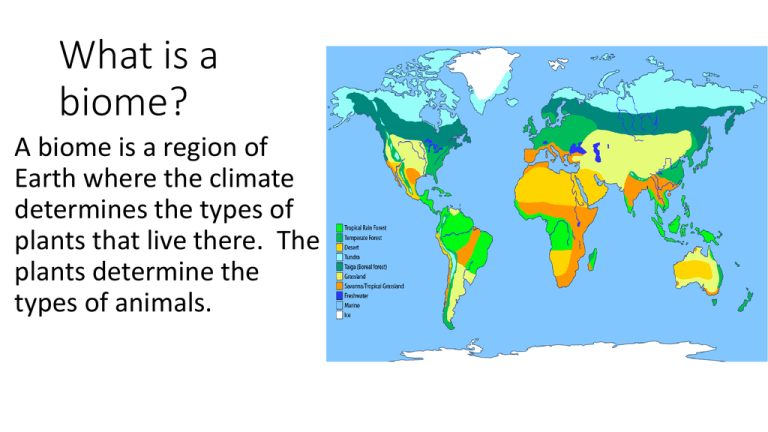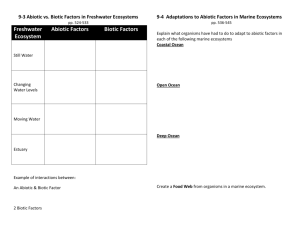What is a biome?
advertisement

What is a biome? A biome is a region of Earth where the climate determines the types of plants that live there. The plants determine the types of animals. What makes each biome different from another? Each biome has a unique community of plants and animals. The type depends on the climate and other abiotic factors. Name the main abiotic factor of a biome. How does it affect the biome? Climate is the main factor of a biome. Biomes closer to the poles receive less solar energy and have colder climates. Biomes closer to the equator have more solar energy and have warmer climates. What are some other abiotic factors of a biome? Other abiotic factors of a biome are soil type, amount of sunlight, and amount of water that is available What is an adaptation? Give an example of a plant and animal adaptation. An adaptation is a feature that allow organisms to survive and reproduce. An example of a plant adaptation is a deciduous tree that loses its leaves in the winter. An example of an animal adaptation is a thick fur coat. How are ecosystems related to biomes? A biome is a large area of land. Within each biome are smaller areas called ecosystems. The ecosystems are specific communities of organisms and their environment. Describe the biotic and abiotic factors of the tundra. Biotic factors: mosses, woody shrubs, musk oxen, ground squirrels Abiotic factors: low average temperature, little precipitation, ground contains permafrost, high mountains, cold and windy Describe the biotic and abiotic factors of the taiga. Biotic factors: coniferous trees, migratory birds, wolves, owls, elk, snowshoe hares Abiotic factors: low average temperature, more precipitation, thin, acidic, nutrient – poor soil, seasons change Describe the biotic and abiotic factors of the temperate deciduous forest. Biotic factors: deciduous trees, songbirds, chipmunks and black bears, deer, bobcats Abiotic factors: nutrient – rich soil, moderate precipitation, hot summers and cold winters Describe the biotic and abiotic factors of the temperate rain forest. Biotic factors: coniferous trees, mosses, ferns, spotted owls, shrews, elk, cougars Abiotic factors: long, cool wet season and a dry summer, nutrient – rich soil Describe the biotic and abiotic factors of the tropical rain forest. Biotic factors: orchids, birds, monkeys, sloths, jaguars, snakes and anteaters Abiotic factors: warm throughout the year, receives more rain than any other biome, acidic and nutrient – poor soil What biome do you think you live in? We live in the temperate deciduous forest biome. What are the three main types of aquatic ecosystems? The three main types of aquatic ecosystems are freshwater ecosystems, estuaries and marine ecosystems Describe each ecosystem. Freshwater ecosystems can be found in rivers, lakes and wetlands. Describe estuaries. Rivers and oceans form estuaries where they meet at the coastline. Describe marine ecosystems. Marine ecosystems are found in the oceans What abiotic factors affect aquatic ecosystems? The abiotic factors that affect aquatic ecosystems are water temperature, water depth, water pH, salinity, and rate of water flow. Describe the organisms that live in a freshwater ecosystem Some of the organisms that live in a freshwater system are protists such as algae and amoeba, frogs, insects, clams, bacteria, worms, turtles, fish and ducks. What is a wetland? A wetland is an area of land that is saturated, or soaked with water for at least part of the year. Bogs, marshes, and swamps are types of wetlands How are wetlands a benefit to the community? In a wetland, water collects and is filtered. This process removes pollutants from the water. Wetlands also protect nearby land and shore from floods and erosion because they can hold water. Name one adaptation an organism has that allows it to live in fast moving water. One adaptation is the immature black fly. It attaches itself to rocks so it won’t get washed away. Rhizoids allow mosses to stick to rocks. What is a unique feature of the organisms that live in an estuary? Organisms in estuaries must be able to survive constantly changing salt levels due to the rise and fall of tides. Name and describe the four zones that make up the marine ecosystem The intertidal zone is the land between high and low tides that includes beaches and rocky shores. Organisms adapt to changing water depths, wave action, exposure to air and changing salinity. Some organisms include crabs, seagrass, barnacles, anemones Name and describe the four zones that make up the marine ecosystem The neritic zone is the underwater zone from the shore to the edge of the continental shelf. Light reaches the bottom of the zone, so algae and plants can live there. Coral reefs and kelp forests are found here. Some organisms include fish anemones, coral, shrimp, brittle stars, and sea otters. Name and describe the four zones that make up the marine ecosystem The bathyal zone extends from the continental shelf to its base and is considered open ocean. It reaches depths of 2,ooo meters. Plankton float on the surface where light is available. Other organisms adapted to the dark and cold are organisms that include sharks, whales, dolphins, fish and sea turtles. Name the zones that make up the marine ecosystem and describe the four The abyssal zone is the area of the ocean below 2,000 meters. It has the coldest and darkest conditions. No light can reach the deep ocean. Organisms must get energy in another way. Microorganisms called archaea convert chemicals released by hydrothermal vents into usable energy. Archaea , tubeworms, crabs, clams and shrimp are part of the hydrothermal vent ecosystem. Why are estuaries important? The mix of salt water and nutrient – rich fresh water in an estuary support breeding grounds for birds, fish, and shellfish such as crabs and shrimp. The grasses protect coastal areas from erosion and flooding.






